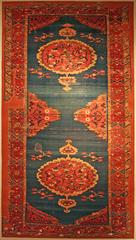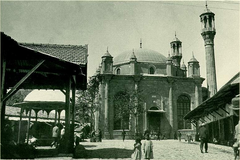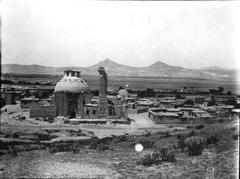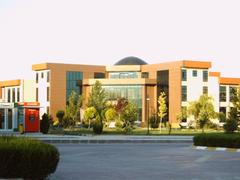Sahip Ata Museum: Visiting Hours, Tickets, and Guide to Konya’s Seljuk Heritage
Date: 04/07/2025
Introduction
Located in the heart of Konya, Turkey, the Sahip Ata Museum is an outstanding example of 13th-century Seljuk architecture and Anatolian Islamic heritage. Originally constructed as part of the Sahip Ata Complex (külliye) by the influential vizier Sahib Ata Fahreddin Ali, the museum today serves as a testament to the Seljuk era’s artistic mastery, social vision, and spiritual life. Within its walls, visitors encounter a unique blend of religious, educational, and civic elements—mosque, mausoleum, dervish lodge, bathhouse, and commercial spaces—integrated into a single urban center.
The complex, built between 1258 and 1285 by master architect Kölük bin Abdullah, embodies the Seljuk approach of merging spiritual devotion, community service, and public welfare. As a museum, it preserves and displays a rich collection of artifacts from the Seljuk, Beylik, and Ottoman periods, including manuscripts, textiles, metalwork, and woodcraft. Its proximity to other major landmarks, such as the Mevlana Museum and Alaeddin Mosque, makes Sahip Ata Museum an essential stop for anyone exploring Konya’s historical landscape.
For practical information like opening hours, ticket details, and guided tours, consult the official Sahip Ata Museum website or trusted local resources (GoKonya).
Table of Contents
- Introduction
- Sahip Ata Museum: A Center of Seljuk Culture
- Visiting Information
- Educational and Cultural Significance
- Frequently Asked Questions (FAQ)
- Conclusion and Resources
Sahip Ata Museum: A Center of Seljuk Culture
Architectural and Artistic Highlights
The Sahip Ata Complex is a prime example of Anatolian Seljuk architecture, renowned for its monumental stone portals, intricate tilework, and harmonious integration of religious and public functions. Key structures include:
- Mosque: Famous for its massive entrance portal, the largest in Konya, decorated with elaborate geometric and calligraphic patterns, including the Basmala and Fatiha Surah (GoKonya).
- Mausoleum: Topped with a glazed brick dome and covered with turquoise and cobalt blue tiles, it houses the tombs of Sahib Ata and his family (Sahip Ata Museum Official).
- Dervish Lodge (Hankah): Featuring a single dome and three iwans, the lodge is adorned with Seljuk ornamental tiles and served as a spiritual retreat for dervishes.
- Bathhouse (Hammam): The largest double bath from the Seljuk period in Konya, maintaining original architectural integrity and separate men’s and women’s sections (Tourist Locations Turkiye).
- Commercial Spaces and Fountains: Shops and public fountains (sebils) provided income for the complex and served the local community, reflecting Seljuk urban values.
Stone carving, muqarnas (stalactite vaults), and elaborate calligraphy highlight the Seljuk mastery of both structural and decorative arts (Daily Sabah). The mosque’s mihrab is a masterpiece of faience tilework and mosaic.
Spiritual Role and Sufi Traditions
The Sahip Ata Complex was designed as a multifunctional center, hosting not only worship but also Sufi gatherings, education, and social services. The presence of the dervish lodge (hankah) underscores its importance in Konya’s vibrant Sufi landscape, which was also shaped by the Mevlevi order founded by Rumi. The complex supported spiritual retreats and communal rituals, and its waqf (charitable endowment) status enabled it to serve the city’s social and religious needs (Wikipedia: Sahib Ata Complex).
Museum Collection and Artistic Legacy
The Sahip Ata Museum displays a diverse ethnographic collection that spans the Seljuk, Beylik, and Ottoman eras (Yollardan). Major highlights include:
- Manuscripts and Calligraphy: Illuminated Qur’ans, religious texts, and imperial edicts (ferman).
- Ceramics and Tiles: Exquisite panels and fragments revealing the evolution of Anatolian tilework.
- Woodwork and Stone Carving: Intricately carved doors, panels, and decorative elements, including the original wing of the mosque’s door.
- Textiles and Carpets: Prayer rugs and Anatolian carpets with traditional motifs.
- Metalwork and Lighting Devices: Brass and bronze candelabras, candlesticks, and other decorative items.
- Arms and Personal Items: Swords inscribed with Quranic verses, devotional beads, and more.
- Clocks and Timepieces: Historical clocks reflecting the importance of timekeeping in Islamic life.
These artifacts provide insight into the material and spiritual culture of medieval Anatolia.
Social Welfare and Urban Life
The complex was conceived as a waqf, with its various structures serving community needs—religious, educational, hygienic, and commercial (Yollardan). Shops and markets within the complex generated revenue to sustain its services, a hallmark of Seljuk and Ottoman urbanism. This model ensured the financial sustainability of religious and public institutions.
Context within Konya’s Heritage
Konya is a city rich in Seljuk and Sufi heritage, home to the Mevlana Museum and other iconic sites. The Sahip Ata Museum’s location places it within a network of historical monuments, allowing visitors to experience the interconnectedness of the city’s religious and civic institutions (TripCrafters, VisitTurkey). The annual Seb-i Arus festival, commemorating Rumi’s death, further highlights Konya’s ongoing spiritual significance.
Visiting Information
Hours, Tickets, and Accessibility
- Opening Hours: Daily, 9:00 AM – 5:00 PM (last admission at 4:30 PM). Some sources note closure on Mondays—check ahead for seasonal or temporary changes (whichmuseum.co.uk).
- Admission: Free for all visitors.
- Guided Tours: Available daily, often at 11:00 AM and 3:00 PM; advance booking is recommended, especially during peak seasons.
- Accessibility: Most areas are wheelchair accessible; ramps and assistance are available on request.
- Photography: Permitted in most areas (except with flash or tripods, which may be restricted).
Getting There and Guided Tours
Located in Meram, about 5 km from Konya city center, the museum is easily reached by public bus, taxi, or on foot from nearby attractions. It is close to the Larende Gate and well-signposted (GoKonya).
Visitor Tips
- Combine your visit with other nearby sites: Mevlana Museum, Alaeddin Mosque, and Karatay Madrassa.
- Visit during weekdays or early mornings to avoid crowds.
- Wear comfortable shoes; the complex covers a large area.
- For the latest updates on special exhibitions, closures, or renovations, check the official website or Evendo.
Educational and Cultural Significance
Since its restoration and reopening as a museum in 2006, Sahip Ata Museum has become a key educational resource for understanding Seljuk culture (GoKonya). It offers interpretive materials and exhibitions that explore the synthesis of Persian, Turkic, and Islamic traditions in Anatolia. Public programming, scholarly research, and community outreach ensure that the site’s rich legacy continues to inspire and inform visitors and locals alike.
Frequently Asked Questions (FAQ)
Q: What are the Sahip Ata Museum’s opening hours?
A: Daily, 9:00 AM–5:00 PM; last entry at 4:30 PM. Check for possible Monday closures or holiday adjustments.
Q: Is there an admission fee?
A: No, entry is free.
Q: Are guided tours available?
A: Yes, typically at 11:00 AM and 3:00 PM; advance booking is advised.
Q: Is the museum accessible for visitors with disabilities?
A: Yes, most areas offer wheelchair access and assistance.
Q: Can I take photos in the museum?
A: Photography is generally allowed, but flash and tripods may be restricted.
Q: How do I get to Sahip Ata Museum?
A: Located in Meram, Konya, easily reached by public transport, taxi, or on foot from central sites.
Conclusion and Resources
The Sahip Ata Museum is a cornerstone of Konya’s historical and spiritual landscape, offering a profound journey into the Seljuk era’s art, architecture, and communal ideals. Its integration of mosque, mausoleum, dervish lodge, and civic structures exemplifies the Seljuk vision of public service and cultural patronage. With free entry, accessible facilities, and a wealth of artifacts, the museum provides an enriching experience for all visitors. Enhance your exploration by combining a visit with nearby Konya attractions and consider joining a guided tour for deeper insight.
For the latest updates, guided tour bookings, and more detailed information, visit the Sahip Ata Museum Official Website and trusted resources such as GoKonya, Tourist Locations Turkiye, and whichmuseum.co.uk.
For more travel tips and updates on Konya’s cultural heritage, download the Audiala app and follow our social media channels.
References
- Sahip Ata Museum Official
- GoKonya
- Tourist Locations Turkiye
- The Konya News
- Daily Sabah
- whichmuseum.co.uk
- Yollardan
- Wikipedia: Sahib Ata Complex
- VisitTurkey: Uncover Konya
- TripCrafters: Konya Tourism and Travel Guide
- Evendo
- turkiyeroutes.com
- Invest in Konya



